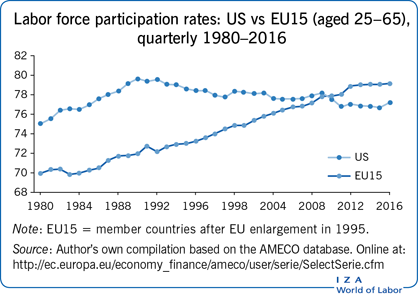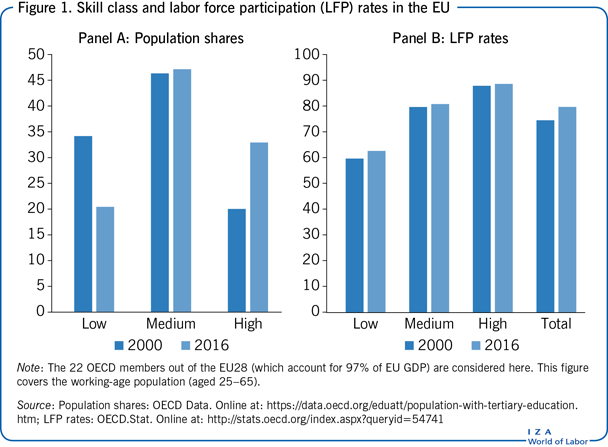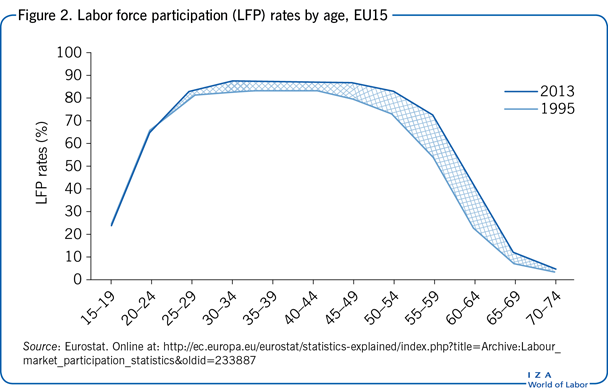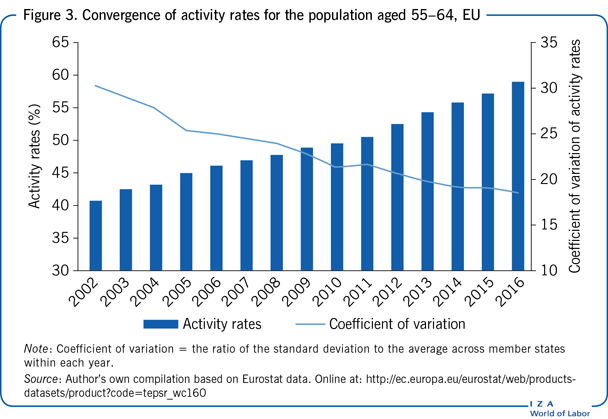Elevator pitch
Employment and labor force participation (LFP) rates have increased throughout Europe since the 1990s, with little interruption from the Great Recession. While many credit labor market reforms for this progress, ongoing educational expansion might actually be more important. This implies that the overall employment rate of an economy can change if the share of the population with tertiary education increases, even in the absence of any labor market reforms or effects of the business cycle. Taking this compositional effect into account makes it possible to disentangle the impact of reforms.

Key findings
Pros
In Europe, employment and LFP rates have increased trend-wise, since the 1990s, with little interruption from the Great Recession.
Due to their higher LFP rates, a rise in the proportion of highly educated people will lead to higher overall participation rates.
Two-thirds of the improvement in LFP rates observed in Europe can be accounted for by the population’s increasing educational achievement levels over the last decades.
There has been a particularly large increase in the LFP rates of the elderly, even accounting for the natural increase expected from their higher education achievements in 2016 (compared to a generation earlier).
Cons
The rise in elderly participation rates is easier to explain with changes to pension systems than with labor market reforms.
It is difficult to pinpoint the impact of particular reform episodes on elderly participation rates, whether aimed at labor markets or pensions rules.
Changes in overall LFP rates are not reliable indicators of the state of the labor market when the workforce composition changes.
Author's main message
LFP rates have increased trend-wise in the EU. This is primarily due to the upgrading of education levels across most countries and age groups. However, increases in the activity rates of the elderly have been larger than expected, even taking into account their higher overall levels of education. This combination suggests that pension reforms and limits to early retirement have also played a critical role in growing participation rates. Ongoing education expansion, especially strong at the tertiary level in south and east Europe and in many Asian countries, should ensure a further increase in occupation and participation rates.
Motivation
Labor market reforms have been on the agenda in Europe for a long time. At the turn of the century, conventional wisdom said that not enough people were participating in the labor market. This inspired one of the key goals of the Lisbon Agenda, namely to match the (then) US employment rate of 70% of the working-age population. This goal was almost achieved by the time the financial crisis hit in 2007–2008. The Great Recession has since brought unemployment to the fore. But as the recovery strengthens, labor markets are again improving, even in the periphery of the Euro area. The key strategic questions for European labor markets are thus whether the improvement until 2007–2008 was due to reforms or other structural changes in labor supply, and how the cyclical trends can be disentangled from the underlying trends?
This article views labor force participation (LFP) rates (understood here as the proportion of the working-age population that is either employed or unemployed) as the main indicator of the state of a labor market, rather than unemployment or employment rates. This is based on the belief that variations in the employment and unemployment rates are driven mainly by the business cycle. While achieving an employment rate of 75% remains one of the headline goals of the EU's official Europe 2020 growth strategy, this now seems impossible to reach. Before the crisis started in 2007/8, close to 70% of the EU's population aged 15–64 worked. One effect of the crisis is that this percentage declined in 19 countries from 2008 to 2013, though the previous peak has now been reached again. For most countries, the employment gains during the pre-crisis boom were not completely erased during the ensuing recession.
Moreover, the high unemployment rates, which still persist in a few countries, have not “discouraged” many workers from leaving the labor force. Contrary to what many expected (and what happened in the US) there has actually been an increase, rather than a fall, in the EU's LFP rate since the crisis.
A longer-term view of European labor markets thus suggests a more positive outlook than that suggested by unemployment rates alone. The key question is: what are the drivers behind this trend-wise increase in participation rates? The European Commission has argued that this is due to the wave of labor market reforms passed in the last six years, especially in countries with adjustment programs [1]. After the acute phase of the crisis passed, reforms concerned job protection, wage setting, and working time. But, reforms have also affected other areas, such as unemployment benefits, notably by decreasing their generosity while increasing coverage.
A key point to consider is that one additional factor has helped push LFP higher, namely educational expansion. Moreover, the increase in LFP has been strongest among one segment of the population: the elderly. This suggests that pension reforms, especially those affecting early retirement, have been more important than labor market reforms.
Discussion of pros and cons
One critical choice to make when it comes to the evaluation of the labor market is the precise definition of the indicator to use, in this case, LFP (activity) rates. In the US, this is usually defined as the ratio of the sum of the employed and the unemployed to the entire population over the age of 15 [2], [3]. This indicator is obviously affected by aging: as the proportion of the elderly increases, this ratio falls, since very few of the elderly (above the age of 64) work. A different definition has been adopted in this article, namely the ratio of the sum of the employed and unemployed to the working-age population. There are many different definitions of “working age” used in official statistics. The age bracket taken here is 25 to 64, since many 15 to 25-year-olds study instead of work, and any increase in the proportion of the young going to college or university might thus show up as a lower LFP rate.
To provide some background on participation trends, the illustration on page 1 shows the LFP rates of the EU15 (the member countries following EU enlargement in 1995) and the US since the 1980s. A very regular upwards trend can be observed for the EU, but not for the US. In the US, the activity rate reached a peak in 1990 and then declined gradually. By contrast, the activity rate for the EU15 starts in 1980 at 70% and increases gradually but continuously (without interruption through the 2007–2008 financial crisis), until the ‘euro’ recession of 2011–2012, when it reaches a plateau just below 80%, but slightly higher than the US value, which is now below 78%. The last 30 years have thus seen a sea change in Europe, with tens of millions more participating in the labor market.
The key role of education
A key empirical pattern with almost universal validity (among OECD countries) is that employment and activity rates vary with skill levels. The higher-skilled have higher employment rates. For example, in 2013, the average employment rate in the EU of those without completed secondary education was about 53%, while it was 83% for those with completed tertiary education. Data on unemployment show the mirror image of this, with substantially lower rates (by about five percentage points (pp)) for those with a tertiary education. Likewise, the difference between the two groups in LFP rates was about 25 pp (63% without completed secondary versus 88% for those with tertiary education). Moreover, the activity rates for those with high educational attainment vary very little across countries. For those with tertiary education, the standard deviation across all 28 EU member states is only 2.4, against 7.4 for those without completed secondary education (more on this below).
The observation that people with higher levels of education perform better in the labor market is not new [4]. The explanation lies somewhere at the crossroad between human capital theory and signaling theory [5], [6]. In terms of the former, employers have a preference for workers with higher education levels because they possess a greater body of knowledge, which benefits the firm. Such knowledge can be sector-specific, as with an engineer who has to compute the resistance of a certain material, or general, like the ability to better communicate findings. Signaling, on the other hand, can play a key role in the hiring process. Faced with many applications, but little personal information about qualifications, a degree from a prestigious institution or better grades might provide a signal of general underlying qualities. However, an influential researcher argued in the 1990s that signaling cannot be a major factor in the long term, since firms would not continue to hire graduates for a long time if workers without a degree, but with more experience, proved to be more productive [7].
At the individual level, the incentive to take up a job is clearly stronger for the higher-skilled since they typically earn much more. In many EU countries, the college wage premium, i.e. the ratio of the average earnings of those with a tertiary degree to those who have not completed secondary education, ranges from 120% to over 200%. Moreover, a high-skilled person also has a much higher probability of finding a job given the much lower unemployment rates for the high-skilled. Thus, for any given reservation wage (i.e. the wage that ensures higher income than unemployment benefits), a college graduate has a much stronger incentive to participate in the labor market.
An important question to examine is whether superior labor market performances remain as higher education becomes a mass phenomenon. The answer is most likely yes [8]. Even in the US, where today over 40% of the working-age population has a tertiary degree, the LFP rate of the high-skilled remains around 80%, compared with 60% for the low-skilled (and there are also large differences in the corresponding unemployment rates) [9]. Further supporting this conclusion is the fact that activity rates for the high-skilled are not lower in countries with a high share of university graduates (compared with other countries where a smaller share of the working-age population completed university).
Moreover, as will be documented below, shifts in the composition of the workforce toward tertiary graduates are not associated with lower activity rates of the lower-skilled. This provides another indication that signaling, which might favor graduates at the expense of others, cannot be the only explanation for the higher activity rates of those with formally higher skills.
The huge difference in employment and LFP rates among those with the lowest and highest skills suggests that there could be important compositional effects on the overall labor market indicators if the composition of the labor force shifts. For example, if 12% of the labor force shifts from the lowest to the highest skill class, and the difference in those classes’ LFP rates was originally 25 pp, all else being equal, an increase in the average LFP rate of 3 pp would be expected, just because of the composition effect. Changes in overall LFP rates are thus unreliable indicators of the state of the labor market when the composition changes. Labor market reforms can be said to affect outcomes mainly if a change in the employment or LFP rates is observed within skill classes (i.e. especially if the low-skilled participate more).
Figure 1 shows the average EU activity rates by skill class and overall for 2000 (the earliest year with consistent data available) and 2016. Panel A shows that the composition of the working-age population has changed: the share of the low-skilled has fallen by about 15 pp, whereas that of the high-skilled has increased by a corresponding amount, leaving the share of the middle-level little changed at somewhat below one-half.

Panel B shows activity rates by skill class and on average. The overall average increased by over 5 pp (from 74.7% to 80%), but within each skill class there was little change. This suggests that a skill upgrade, rather than labor market reforms, has been responsible for most of the progress seen since the turn of the century.
The participation of the high skill class (those with tertiary education) and those with medium skills (those with completed secondary education) increased only marginally (by 1 pp). The only group for which discernable progress is observed is the low-skilled (those with less than completed secondary education, or the International Standard Classification of Education (ISCED) level 0–2) whose participation rate increased by over 3 pp (from 59.7% to 63%) over this period. If looking to trace the impact of labor market reforms, the focus would have to be on this segment of the population.
A simple way to disentangle the influence of skill upgrading from all other effects is to compute the overall activity rates that would have resulted if only the activity rates by skill group had changed, but the composition of the labor force had remained unchanged. Weighting the 2016 activity rates with the 2000 skill composition yields an average activity rate of 76.5%. This implies that improvement in the composition of the European labor force contributed an additional 3.5 pp.
The actual changes in the composition of the working-age population correspond roughly to the numerical example given above: Figure 1 shows that between 2000 and 2016, the share of the low-skilled population fell more than 12 pp. Over this period, the share of those with tertiary education grew by almost exactly the same amount (12.8 pp), and there was also a slight increase in the share of the middle-skilled. This can be characterized as a switch of approximately 12% of the working-age population from low- to high-skilled, with the latter group having an activity rate about 25 pp higher than the former. One would then expect a 3 pp improvement of the activity rate.
This simple examination of activity rates by educational attainment thus suggests that the shift in the composition of the workforce by itself could account for about two-thirds of the overall increase in activity rates in Europe since 2000.
Aging
It is well known that the European labor force is aging. Moreover, the participation rate usually declines with age (after the so-called prime age of about 45 years). This means that, all things being equal, aging would be expected to have a negative impact on activity rates (and thus on the pool of the working-age population available for the labor market). However, it seems that there is a strong trend in the opposite direction.
As shown in the illustration on page 1, the activity rate has increased considerably over the last 20 years. Figure 2 disaggregates this rate by age, comparing 1995 data with that from 2013 (the last available year with full data). It is apparent that overall LFP rates are very high between the ages of 25 and 45–50. After that age, the rates fall off quickly, but how quickly has changed substantially over the last 20 years: the difference between the curves from 1995 and 2013 is rather small until about 45 years of age, and then widens rapidly. This implies that the most significant change from 1995 until 2016 has been the attachment of the elderly to the workforce, as evidenced by the almost 20 pp increase for those between the ages of 55 and 64. The key question is now: what were the reasons behind this change?

Do reforms matter?
The fact that employment and activity rates vary systematically with education levels suggests that the success of reforms should be measured, not by the overall employment and activity rates, but rather by how these indicators have changed for each specific skill class.
Figure 1 shows this for the total working-age population, aggregating all age groups. The main message is that the overall increase in activity rates observed over the last ten years for the EU28 (2.8 pp) is much larger than the improvement observed within most skill groups. The only skill class for which a significant increase in activity rates is actually observed is the low-skilled one. This should be seen as a success, since the purpose of most labor market reforms is to improve the participation of this group. However, Figure 2 suggests that the improvement of participation rates has been concentrated among the elderly. Hence, it is useful to analyze to what extent there has been an improvement in the activity rates by skill class and age group.
The following discussion concentrates on the older cohort of workers (aged 55–64) and on the subgroup of the low-skilled (compared to the overall cohort).
The European Commission has argued that the effectiveness of recent labor market and pension reforms enacted by euro area countries under financial stress can be seen via the increase in LFP rates among the elderly (aged 55–64) [1]. This is partially confirmed by the data. The activity rates of the those aged 55–64 in the EU reached almost 60% in 2016, from about 40% in 2003, as shown by the vertical bars in Figure 3, which increase by about 1 pp per year.

Moreover, the figure reveals a considerable amount of convergence within the EU (see [10] for an analysis of the US case, which is quite different). This implies that the change in the LFP of the elderly was a broad movement, and that those countries where the activity rates of the elderly were lowest in 2003 improved the most over the next ten years.
A key question is thus: Is the improvement in overall participation rates due to reforms or to the composition effect? Given that the educational profile of the elderly is changing quickly, their LFP rates should be viewed by education level with a special focus on the subgroup of the low-skilled (compared to the overall cohort). This is done in Figure 3, which shows that there has been considerable improvement in the activity rates of this “marginal group” of low-skilled elderly as well. However, their activity rate remains much lower than the area-wide average for all age groups; and the 15 pp increase from 2003 to 2016 was less than that of the total (which was almost 20 pp).
The convergence of activity rates for the low-skilled elderly has also been strong, as evidenced by the steep fall of the coefficient of variation. Overall, the activity rate data on the low-skilled elderly thus suggest that there has been considerable improvement in their labor market participation, albeit starting from a rather low level. This further suggests that there has been some structural change in the labor market conditions of the elderly, which goes beyond the change in skill composition that affects all age groups.
Limitations and gaps
Any analysis of European labor markets has to deal with a host of practical data issues. Different countries can display quite different patterns, not only because of varied national institutions, but also because the business cycle impacts national labor markets in different ways. The use of multi-country averages to average out these national idiosyncratic elements requires researchers to make difficult choices. For example, countries from Central and Eastern Europe were engaged in a radical process of transition during much of the 1990s. This implies that their pre-2000 data will be affected by different factors than that from the (15) “old” member states. This article has thus concentrated mostly on the advanced EU countries with a settled industrial structure.
This analysis has uncovered some striking developments in LFP patterns. The hypothesis that reforms in individual member countries were the key reason for increases in the participation rates is difficult to reconcile with the gradual and trend-wise increase in the activity rates of the elderly across countries and over time. It is difficult to pinpoint the results of individual labor market reforms because reforms across countries cannot be compared because they usually cover different aspects; and, for each specific country, it is difficult to disentangle the impact of a reform from the business cycle.
Summary and policy advice
European labor markets exhibit important long-term trends which contradict the widely held view that excessive regulation impedes job growth. LFP rates have been increasing for more than 20 years. Moreover, the Great Recession has barely slowed this progress, even though one would expect that such a prolonged period of high unemployment would lead many discouraged job-seekers to abandon the labor market altogether.
The overall increase in activity rates across the EU seems to have two sources. First, the composition of the labor force is changing rapidly, with the share of the low-skilled falling and that of the high-skilled increasing. Given that the latter have much higher employment rates, one would expect average activity rates to increase based solely on this change. Second, there has been an increase in the activity rates of the low-skilled.
The second finding would suggest that labor market reforms have made it more attractive for the low-skilled to enter the labor force. But closer inspection reveals that activity rates have increased mainly for the elderly among the low-skilled. There has been little change in the LFP rates of low-skilled non-elderly adults, and the rates for unskilled youth have actually fallen in some cases [11]. This suggests that pension reforms, in particular changes to early retirement rules, might have been more important than general labor market reforms (such as changing the costs of hiring and firing).
Moreover, the increase in elderly activity rates (of all skill classes) has been broad-based and trend-wise. However, with the possible exception of the German “Hartz” reforms, it seems difficult to identify specific reform episodes, whether to pension systems or labor markets, which had an impact on this trend.
Overall, findings suggest that European labor markets are changing, but the main drivers seem to be the “massification” of tertiary education and the tightening of early retirement conditions, rather than reforms of the labor market itself. One corollary of this view is that the ongoing education expansion, especially in Europe's south, should ensure a further increase in employment and participation rates.
Acknowledgments
The author thanks two anonymous referees and the IZA World of Labor editors for many helpful suggestions on earlier drafts, and Matthias Busse and Karolien Lenaerts for excellent research assistance.
Competing interests
The IZA World of Labor project is committed to the IZA Code of Conduct. The author declares to have observed the principles outlined in the code.
© Daniel Gros